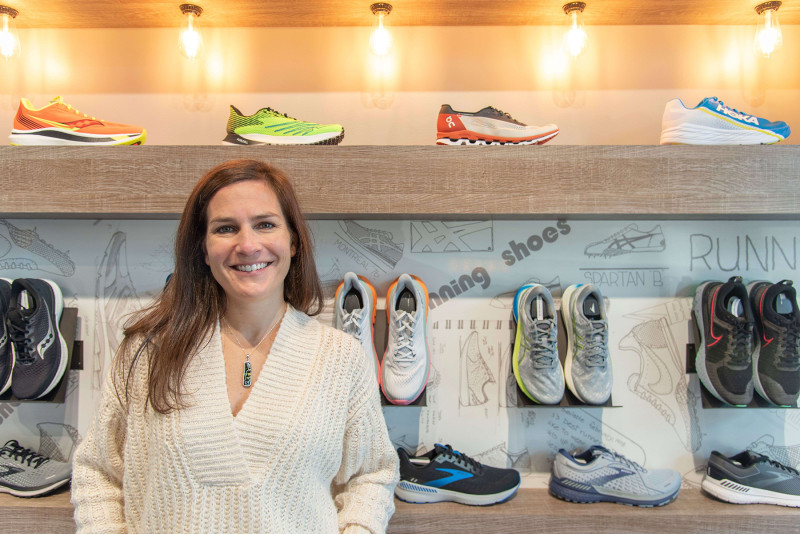On a Monday morning in January, Catherine Moloznik descends the steps of Fleet Feet’s second-floor headquarters in Carrboro, NC, and strides into the company’s flagship store.
She spends a good chunk of the morning in conversation with Pam Zieger, the store’s operating partner, as well as Johanna Iwanicki, Fleet Feet’s newly minted merchandising manager. The trio earnestly discusses contemporary consumer needs, an exploration that naturally leads to purchasing and merchandising, two areas that sit neatly in Moloznik’s wheelhouse.
In early 2020, Moloznik and her husband, John, moved their family to North Carolina as both Fleet Feet Chicago veterans accepted positions with Fleet Feet’s corporate office. While John turned his attention to business development initiatives, Catherine Moloznik was tasked to oversee purchasing and merchandising at Fleet Feet’s 34 corporate-owned doors as the company’s director of merchandise planning and analytics.
And she acknowledges it’s a rapidly evolving world in the age of COVID-19.
“Given COVID’s presence, you’ve basically got one shot to sell to the customer when they’re in your store because it’s not likely they’re coming back anytime soon,” Moloznik says. “So, have your mannequins tidied up, the right product available and an understanding of customer traffic in your store.”
Run Shops in the Age of COVID
In many run shops, various corporate-owned Fleet Feet doors included, sit-and-fit footwear areas have swelled to accommodate social distancing. As these enlarged footwear areas have gobbled up more floor space, some apparel, accessories and fixtures have been pushed off the floor, which has forced run shop operators to be more deliberate with merchandising as well as purchasing, Moloznik says.
“With these bubbles around the fit area, you need to think about how you can safely showcase the products you have,” she says, adding that COVID has compelled her to “think twice” about the in-store product mix. “You need the right products and sell-through because you can’t have excess inventory cluttering up the showroom and confusing the customer.”
While paring down inventory to the “best of the best” requires a process of “brutal editing,” Moloznik nevertheless believes it’s been a productive and necessary endeavor Ñ and one that will remain so moving forward.
“It’s a positive in that it has made categories more profitable and less cluttered,” says Moloznik, who received the Nike Just Do It Award at The Running Event in 2017.
Simultaneously, Moloznik has also noticed a shift in consumers’ shopping habits. She says customers seem far more intentional with their visits to brick-and-mortar storefronts, less inclined to shop around and more mission-focused, some even carrying a mental, if not written, list of what they need.
“In some ways, sales are easier now because people are coming into our doors with a high intent to purchase,” she says. “Though that often means footwear, there’s an opportunity here to show head-to-toe solutions and everything we can provide, albeit in a safe, clear way.”
And that, she contends, heightens the importance of merchandising now more than ever before.
Merchandising With A Purpose
Working through planograms and thinking about what merchandising looks like down to the fixture level, Moloznik stresses that merchandising is more than “just an apparel conversation.” From the store windows, traffic patterns and sightlines through the store to storytelling aides and bringing footwear samples off the shoe wall, Moloznik says the aim is to make merchandising a more holistic story beyond how apparel hangs on a rack or where hydration accessories sit in the store.
“We’re not afraid to blend the categories together and, in fact, see value in doing that,” Moloznik says.
She emphasizes the importance of storytelling to “add life to a collection” as well as opportunities for consumer education. This might include attaching little cards communicating product information to displays, “silent sellers” like prominently showcasing a jacket with 360-degree reflectivity on a window mannequin or having a Staff Picks section in which store associates highlight their favorite products and briefly identify why the items dazzle.
“You can catch people’s attention, provide information quickly and do it in a way that feels authentic,” Moloznik says, noting that the run specialty marketplace is full of rich brand and product stories that can appeal to customers’ sensibilities.
And much like the novelist, store operators shouldn’t be afraid to embrace some creativity in their storytelling. Consider, for instance, setting a pair of trail shoes upon a layer of gravel and rocks running across a table. Such a visual display, Moloznik says, would clearly communicate the footwear’s intent.
“Make it an experience for the consumer and they will get it,” she assures. “It’s a tough environment these days for run shops, but you can sell the whole store with the right merchandising and traffic flow.”






